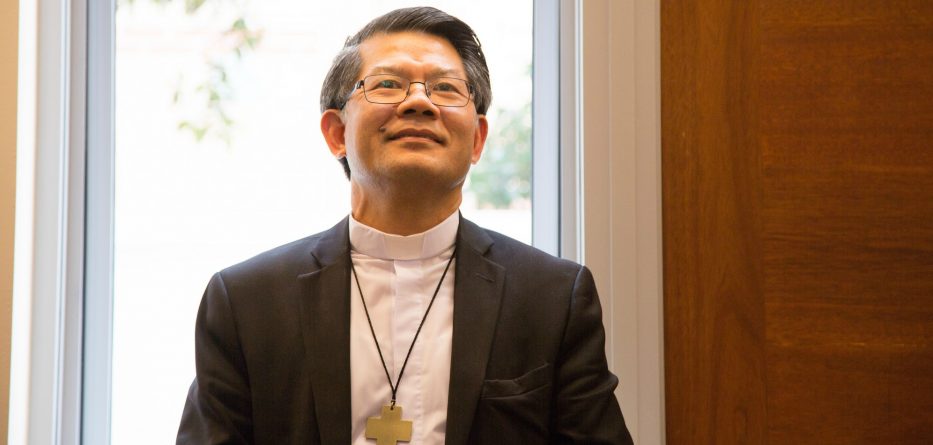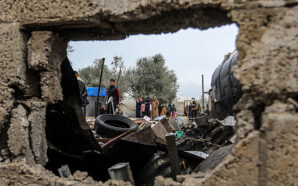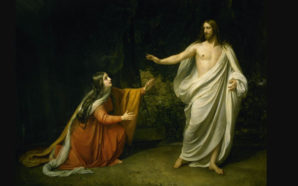Most Reverend Vincent Long Van Nguyen OFM Conv DD STL, Bishop of Parramatta
Address to the National Council of Priests, Canberra, Australia, 11 September 2018
Address to the National Assembly of Diocesan Priests, Christchurch, New Zealand, 13 September 2018
“Being a priest in an unprecedented time of change”
INTRODUCTION:
Tena Koutou Katoa!
It is a privilege for me to join you in this National Assembly of Diocesan Priests here in beautiful Christchurch, New Zealand. I thank you for the honour of being able to share with you my reflection on the priesthood in this time of great turmoil and upheaval in the Catholic Church worldwide.
In Australia, we have recently completed a five-year-long Royal Commission into Institutional Response to Child Sexual Abuse. It was the most comprehensive inquiry of its kind in the world and it shone a spotlight on not just individual perpetrators but also the dysfunctional and corrosive culture of the Church, which has promoted and protected the interests of the institution over against the welfare of victims/survivors.
We have had an Australian Archbishop convicted of a historic child sex abuse cover up. We even have an Australian Cardinal on trial for child sex abuse allegations.
The crisis we face in the Church is deep-seated, perhaps not unlike the financial institutions whose culture of corruption and self-interest has been exposed in a fresh Royal Commission. Indeed, to many people, Catholics included, it is not only the case of a few bad apples. It is more like the apple that is rotten at its core.
This does not seem like an overstatement in the light of continuing revelations of clerical sexual abuse right across the globe. Recently, the Chilean bishops after a period of discernment in the Vatican tendered their resignation en masse. The Pope has accepted five of them, including Bishop Juan Barros who was appointed in controversial circumstances.
Likewise, in America following the grand jury report, there have been calls for the bishops there to do the same. Then of course, just a couple of weeks ago, the dirt hit the fan in the Vatican itself.
While Pope Francis was in Ireland for the World Meeting of Families, the former nuncio to the USA decided to spoil the party. He released a long letter accusing Pope Francis of covering up the McCarrick affair and demanding that the Pope resign. Who needs enemies with friends like that? This open opposition and hostility against a reigning pontiff was totally unprecedented.
The sexual abuse crisis is inundating the whole Church like a tsunami and it has the potential to cause long-term damage, chaos and even schism. (Mind you, there is already a silent schism in that the majority of Catholics in many parts of the world have simply walked away from the practice of the faith.) It is the biggest crisis since the Reformation and it exposes the ideological conflicts that run more deeply than the New Zealand fault lines through the length and breadth of the universal Church.
The anti-Pope Francis forces have accelerated their frontal attacks against him in a coordinated and virulent manner. The gloves are clearly off and they have seized this moment of turmoil as an opportunity to undermine his papacy and derail his reform agenda. What is interesting, too, is the number of prominent clergy and laity who have chosen to sympathise with these forces and therefore shown their not so subtle disapproval of the way the Pope is leading the Church.
Clearly, Captain Francis will have to weather both the storm and the mutiny onboard. I just hope and pray that he stay the course because nothing less than a deep and comprehensive reform will restore confidence and trust in the Church.
Pope Francis has unleashed a new energy, he has poured a new wine which cannot be contained in old wineskins. He has challenged us to move in concert with him and bring about the rebirth of the Church. I am endeavouring to follow the pope’s lead. I have forfeited my Oneworld club membership and now fly with no-frills budget airlines regularly – on a wing and a prayer. But that’s the easy part.
The harder part is to do what most of you do, which is to labour at the coalface of the Church.
It is have the smell of the sheep, to accompany our people in their joys and griefs, hopes and struggles. Transition times call for deep discernment, courageous imagination and prophetic action.
Like Noah before the flood, we must be able to prepare for what is around the bend. Like the prophets who accompanied their people into exile, who interpreted the signs of the times and led them in the direction of the Kingdom, we must do the same for our people in the context of this new millennium.
Like Ezekiel who dream and enact the dream of the New Temple, we must embody the vision of the Church made anew and the priesthood made anew from the ashes of the old clericalist model. We must learn to re-incarnate the spirit of Jesus, faithful to the past but also creative to the present and courageous to the future.
BREAKING THE CLERICAL CULTURE:
It is becoming increasingly evident that clerical sexual abuse crisis is a symptom of a dysfunctional, corrosive and destructive culture in the Church. Pope Francis often denounces clericalism, which he sees as being endemic to many aspects and levels of the institutional Church such as the Roman Curia, Diocesan structures, seminaries et cetera. (For example, he compares ill-prepared young priests to little monsters and speaks of the pathology of power as one of 15 diseases of clericalism.)
Ultimately, it is not just a question of individual manifestations of clericalism.
Indeed there were and have been great priests who lived and ministered heroically even within the constraints of the old mould.
Still, it is a question of clericalism inherent in the very culture of the Church, which we must look at very honestly. In his letter following the Chilean scandal, Pope Francis wrote: “It would be irresponsible not to go deep in looking for the roots and structures that allowed these evil acts to happen and simply to go on.”
The culture of clerical hegemony has been solidly entrenched in the Catholic Church ever since it took centre stage in the Roman Empire. It is a by-product of the model of Church, which sees itself as self-sufficient, superior to and separate from the outside world. Its security, reputation and internal relationships are the centre of attention. The Church in this model becomes the Church of the ordained at the expense of the baptised.
As a result, the ordained becomes an exalted and elitist club that protects the interests and privileges its members. This explains the obfuscation and cover-up, which is so endemic to this club mentality. It is a far cry from the model of the Humble Servant that Jesus exemplified and this celibate clerical club provides the ideal condition for the disease of clericalism to fester.
In my opinion, we really need to once and for all jettison the clericalist model of Church with its byproduct of the exclusive clerical club. It has served us well beyond its use by date. The Church as understood and articulated by the Second Vatican Council sees itself as a pilgrim People of God, incarnate in the world. It is a new paradigm – one that is based on mutuality not exclusion, love not fear, service not clericalism, engagement with the world not flight from or hostility against it, incarnate grace not dualism.
The time has come for us to embrace and implement unambiguously and decisively the vision of the pilgrim Church, that the Second Vatican Council entrusted to us. The time has come for the Church to be truly the Church of the baptised and together with the ordained, all the People of God can create a new culture of humility, accountability and service.
The model of the Church based on clerical hegemony has run its course. Insofar as it is deeply embedded in patriarchal and monarchical structures, it is incapable of helping us to meet the needs of the world and culture in which we live. We have long moved out of the Ancien Regime and the age of absolute monarchs. We are on this side of the secular state and the rise of democracy.
Yet it seems that the deeply entrenched patriarchal and monarchical structures of the Church have failed to correspond with our lived experience. In fact, important as it is to consider the question of women ordained ministries in the Church (for which the Study Commission on Women’s Diaconate was set up), it is far worse to persist with structures that fail to convey the message of the Gospel to the deep yearnings of men and women of today.
Adding women into the archaic structures that need fundamental reforms may be likened to pouring new wine into old wineskins.
For the Church to flourish, it is crucial that we come to terms with the flaws of clericalism and move beyond its patriarchal and monarchical matrix. The Pope famously said that we need a new theology of women. I would like to postulate that what we need even more is to find fresh ways of being Church and fresh ways of ministry and service for both men and women disciples.
BREAKING OPEN THE PRIESTHOOD:
The separated, exalted and elitist priesthood, which is a byproduct of the ecclesiology that emphasises the perfection of the Church must be consigned to the past. This kind of priesthood has been mystified by a notion that a priest has exclusive and privileged access to the divine.
This religious elevation is suspect and unreal to say the least in the light of the clerical sexual abuse crisis. In fact, such an image of a priest has become discredited and shattered. There is no going back to the self-enclosed, elevated and exalted clerical world. Your magnificent Cathedral of Christchurch, which was destroyed by the recent earthquake may or may not be rebuilt because of the extent of the damage. We can be certain that the pieces of the old exalted and elitist priesthood cannot be put back together.
The myth of the mysterious, heroic, uncontaminated, unblemished “men in black” has imploded.
Instead of doctoring the image and reviving the mythology and mystique of the priesthood of yesterday, we can accept that what has been destroyed is irretrievable. Perhaps the end of the old world could lead to a new era and the current crisis offers the priesthood a chance to free itself from the manacle of clericalism.
The priest is not a lone and exalted figure exclusively chosen and gifted with something, which most people do not have. Rather, the priest is the presence in whom the implicit priesthood of the baptised is called to become explicit and active. In this way, we learn to discover a deeper and more holistic identity as members of the People of God and as presbyters in the sense of going in front leading people but not hermetically sealed from them.
We must rediscover the specific and full charism of the priesthood within the matrix of the universal priesthood of the faithful. The priesthood cannot be lived fully apart from the community of disciples. This is one of the key insights of the Vatican Council. The Church is not the Church of the ordained but of all the baptised.
There existed a variety of ministries in the early Church. Paul bears witness to this when he lists a number of gifts or charisms that Christ gave to the Church for the building up of His body. Yet over the centuries, this richness has been gradually concentrated in the ordained at the expense of the baptised.
In effect, the priesthood of the ordained has assumed and usurped the rich and varied ministries of the baptised. It is time, therefore, that the notion of priesthood needs to break open anew so as to fully honour what Paul says, “everyone is given grace according to the measure of the gift of Christ.”
If we are to break open the priesthood and allow the ministries of the baptised to flourish, I think we will need to revisit the clerical and patriarchal culture along with its many institutional dynamics such as titles, privileges, customs, structures et cetera. I am not suggesting the ordained and the non-ordained should be collapsed into one another.
Rather, each one should complement rather than stifle the other. I hold that those institutional dynamics that breed clerical superiority, elitism and power over against the non-ordained, stifle rather than facilitate the outpouring of grace through the whole body of Christ.
Furthermore, it is my conviction that the priesthood “pedestalised” is the priesthood dehumanised. It is bound to lead us into the illusion of a messiah complex and an inability to claim our wounded humanity and to minister in partnership. What we need to do is to humanise the priesthood so as best to equip ourselves with relational power for authentic Gospel living and service.
PRIESTHOOD ORIENTED TO MUTUALITY AND PARTNERSHIP:
In the end, though, I firmly believe that we are on the threshold of renewal and transformation of the priesthood. Like the wedding feast of Cana, the wine of old has served the Church well but it is running out. The old way of being a priest has, likewise, well served the Church we love. But that model of the exalted, separated and elitist priesthood is drawing its last breaths – at least in many parts of the world including Australia.
There is a better wine that the good Lord has prepared for us.
The new wine of God’s unconditional love, boundless mercy, radical inclusivity and equality needs to be poured into new wineskins of humility, mutuality, compassion and powerlessness. The old wineskins of triumphalism, authoritarianism and supremacy, abetted by clerical power, superiority, and rigidity, are breaking.
When Jesus sent out his disciples on a mission to announce the Good News, he sent them not as lone rangers but in pairs. What I derive from that practice of his is that Christians can only minister effectively when they recognise their limits as individual and are open to partnership with others. Priests particularly must learn to minister in relationship with one another and with their community.
Yet, ironically, the whole clerical culture is often geared towards individual heroism and even Messiah complex.
The Cure d’Ars is probably the patron saint par excellence of the kind of priestly individual heroism. No wonder many of us suffer from ministerial burn out, depression and loneliness.
If the priesthood has a better future, it has to be humanised; it has to find expression in better mutual support, collaboration and partnership. It has to free itself from the variant strains of clericalism such as sexism, narcissism and paternalism.
While ordained for service, the priest remains not apart from but a part of the faithful in need of support, ministry and community.
Though he preaches, he listens with open heart to the preaching of others. (When I am home with my mother, I am keen to hear pearls of wisdom from the real preacher!)
Though he blesses, he also bows his head to receive the blessings of others. (Pope Francis’ gesture at his first appearance was refreshing.)
Though he leads with a leadership of service, he must be willing to be led by others.
Though he ministers, he also recognises the ministerial charisms in others and works with them in collaborative ministry for the good of the community. Maintaining the healthy tension of this dialectic is a key to the priesthood oriented to mutuality and partnership.
It seems to me that the Church cannot have a better future if it persists in the old paradigm of triumphalism, self-reference and male supremacy.
So long as we continue to exclude women from the Church’ governance structures, decision making processes and institutional functions, we deprive ourselves of the richness of our full humanity.
So long as we continue to make women invisible and inferior in the Church’s language, liturgy, theology and law, we impoverish ourselves as if we heard with only one ear, we saw with only one eye and we thought with only one half of the brain – and often the lowest reptilian section thereof. Until we have truly incorporated the gift of women and the feminine dimension of our Christian faith, we will not be able to fully energise the life of the Church.
CONCLUSION:
I am a former refugee and as such I have a deep and personal interest in the biblical period of the exile, both as a historical development and a metaphor. The exile did not happen out of a vacuum. It was preceded by the political and social disorder.
Indeed, Jewish society, which was meant to be an alternative social system to a pre-exodus Egypt had become oppressive and exploitative.
As pre-Exilic prophets, such as Amos, Micah and Isaiah pointed out, it was marked by systemic injustice, that is, injustice that was built into the very structures of society. With the emergence of a powerful kingship beginning with Saul, a domination system was re-established, ironically in the land of promise and freedom. Solomon became a new Pharaoh and Egypt was reborn in Israel.
The exile, painful as it was, turned out to be a time of renewal. It shone a spotlight on the systemic injustice that needed to be addressed. Through the prophets of the exile, the Israelites learned to live their faith anew – without familiar symbols like the temple, the temple-based priesthood, the festivals, the land et cetera. They learned to re-engage their faith tradition critically and imagine their new alien world differently. They taught us the art of prophetic imagination that can re-energise and enliven us with new possibilities.
It seems to me that the biblical metaphor of the exile is pertinent for us as we learn to acknowledge and tackle the systemic malaise in the Church. Like Israel before the exile, the Church has failed to be a place of promise and freedom. It has not lived out the radical vision of powerlessness of the Servant Lord. Its dysfunctional and destructive culture of clericalism has betrayed the Gospel.
As the Church enters a time of darkness, it must have the courage to embark upon the journey of conversion, which will lead to cleansing, renewal and revitalisation. The paschal rhythm summons us to a discipleship of humility, weakness and vulnerability, of dying and rising in Christ.
As the Church, we must die to the old ways of being Church, which is steeped in a culture of clerical power, dominance and privilege. We must abandon the old paradigm of a fortress Church, which is prone to exclusivity and elitism. We must learn to rise to Christlike way of humility, inclusivity, compassion and powerlessness.
We priests have a critical role in the cleansing, renewal and revitalisation of the Church. Like Moses who ascended on Mount Nebo and showed the people the Promise Land in a misty distance, we can act as forerunners and pioneers, even if we ourselves may not be able to see the reality of what is hoped for.
Like prophets of the exile, we can dream and enact the dream of the new temple where diverse life forms flourish. We can embody the vision of the Church made anew and the priesthood made anew from the ashes of the old clericalist model.
May the Holy Spirit accompany us as we move boldly and decisively in the direction of the Kingdom!
Kia ora!
Most Rev Vincent Long Van Nguyen OFM Conv
Bishop of Parramatta








